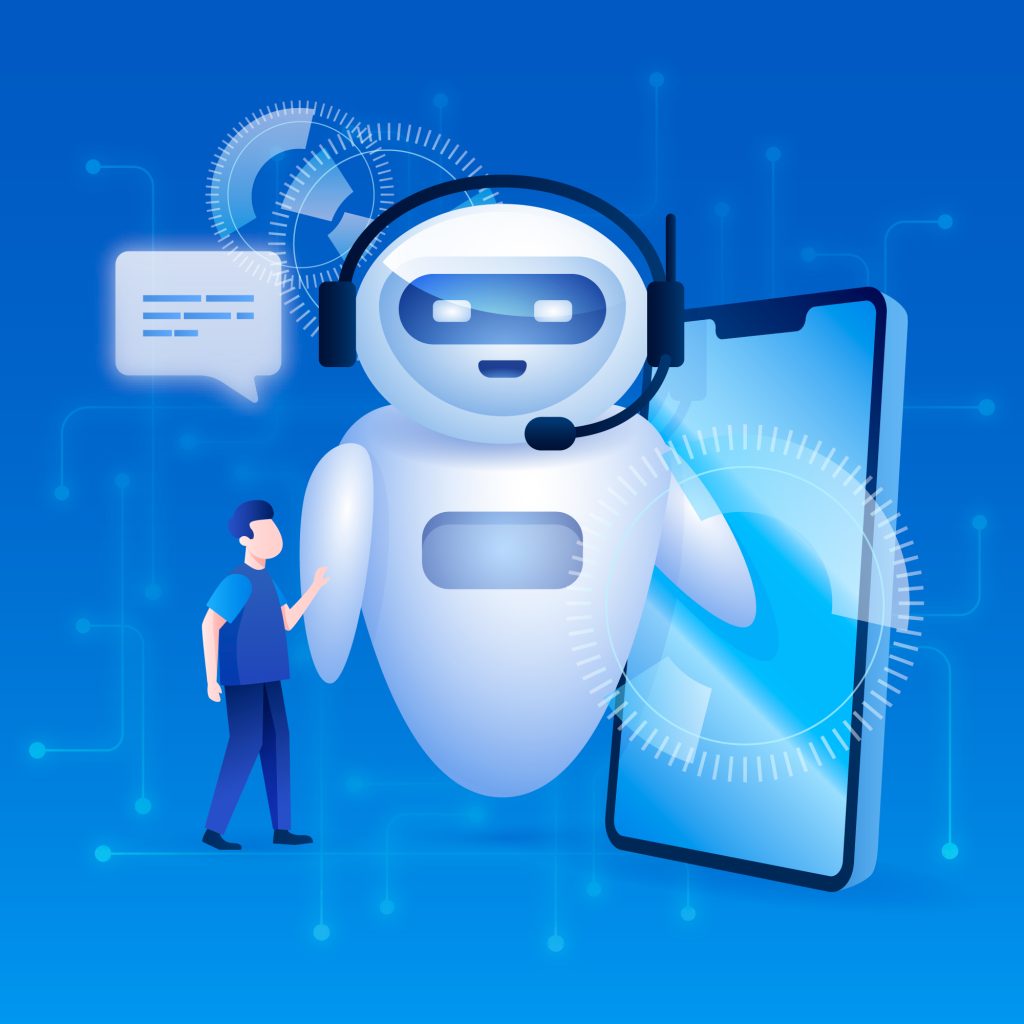Create a Chatbot for Small Business

The marketing team at MyDirecteur was researching ways of creating a unique chatbot for our customers that could help them find the best small business for you. This can easily be used to create a chatbot for a small business. We came across Typeform. This is a really cool form-creating tool that you can use to create unique chatbots that can help you get attention from your customers. Before we look at how to create a chatbot, let’s first see how small businesses can benefit from AI.
How chatbots help small businesses?
Chatbot for small business may be very advantageous for small businesses in many ways, such as:
- Better customer service: Chatbots respond quickly to consumer queries, guaranteeing rapid assistance and raising customer satisfaction. They may deal with basic and repeated questions, freeing human resources to concentrate on more complicated problems.
- 24/7 accessibility: Chatbots may work around the clock, allowing businesses to interact with consumers and provide service anytime. This is especially beneficial for small enterprises with limited employees or those who serve clients across multiple time zones.
- Cost-effective solution: Implementation of a chatbot for small business can save operating expenses by automating client interactions and removing the need for specialized customer care staff. Small firms may offer effective support without expanding their workforce.
- Efficiency improves: Because chatbots can manage numerous conversations simultaneously, organizations can respond to consumer questions quickly and effectively. Small businesses can handle a larger volume of customer inquiries because of this tool without sacrificing the level of service.
- Lead generation and sales support: Chatbot for small business may interact with clients, acquire pertinent data, and provide tailored product recommendations. They may help generate leads, walk potential buyers through the buying process, and hence increase conversion rates.
- Collection of data and analysis: Chatbots may gather important consumer information and offer insights into preferences, behaviors, and challenges. Small firms may utilize this information to improve their product offers, marketing strategy, and business judgment.
Chatbots give small businesses a low-cost way to increase interaction, deliver good customer assistance, create leads, and collect essential data, all of which help companies grow and succeed.
How to create a chatbot for free
Typeform is a popular platform for creating online forms and surveys. While it is primarily used for collecting data, it can also be used to create interactive chatbots for your small business. Here are the steps to create a chatbot using Typeform:
- Sign up for a Typeform account: If you don’t already have an account, sign up for one on the Typeform website.
- Create a new form: Click on “Create a new form” to get started. Choose the chatbot template to begin building your chatbot.
- Design the conversation flow: Typeform allows you to create conversational experiences by using branching logic to direct users to different questions or sections of your form. Use this feature to design the conversation flow that your chatbot for small business will have with users.
- Add messages and questions: Add messages and questions to your chatbot by clicking on the “+” icon and selecting the type of question or message you want to add.
- Customize the design: Typeform allows you to customize the design of your chatbot for small business to match your brand. You can change the font, color, and background to make it look more appealing.
- Test and refine: Test your chatbot with real users and make adjustments based on their feedback. Continuously monitor its performance and refine its capabilities to improve its functionality and effectiveness.
- Integrate the chatbot: Once you’re satisfied with your chatbot, integrate it into your website or messaging platform. Typeform provides different integration options such as embedding the chatbot into a website, using a chat widget or connecting it to messaging apps like WhatsApp.
Overall, creating a chatbot using Typeform is a great option for small businesses who want to create a conversational experience without any coding knowledge. With its user-friendly interface, customizable design, and integrations, you can quickly create and deploy a chatbot for small business to engage with your customers.

Checkout the chatbot that we created here: Best Small Business to Start in 2023 Quiz
Small business chatbot key considerations
When creating a chatbot for small business, there are several things that should be considered:
- Determine the purpose of the chatbot: What is the main objective of the chatbot? Will it be used for customer service, sales, or lead generation? Understanding the purpose of the chatbot will help you determine what features and functionalities it should have.
- Identify the target audience: Who is the chatbot intended for? Understanding the target audience will help you design the chatbot’s personality, tone, and style of communication.
- Design a conversational flow: The chatbot should have a well-structured conversational flow to ensure that it is easy to use and understand. The flow should be designed to guide users towards their desired outcome, whether it’s making a purchase, getting information, or resolving an issue.
- Keep it simple: A chatbot for small business should be designed to be simple and easy to use. Avoid using technical jargon or complicated language that may confuse users.
- Test the chatbot: Before launching the chatbot, it is important to test it thoroughly to ensure that it is working as intended. This can be done by conducting user testing and collecting feedback from early users.
- Consider integration: The chatbot should be designed to integrate with existing systems and tools that the business is already using, such as customer relationship management (CRM) software, email marketing tools, or payment processing platforms.
- Continuously improve: Once the chatbot for small business is launched, it is important to continue to monitor its performance and make improvements over time. This can be done by analyzing user data and feedback, and making updates to the chatbot’s conversational flow and features as needed.
Some sample scenarios that a chatbot for small business can be used for include:
| Purpose | Prompt | Sample Chatbot for Small Business Responses |
|---|---|---|
| Customer Service | User asks for help with an order | User: “I have a problem with my order.” <br> Chatbot: “I’m sorry to hear that. Can you please provide your order number so I can look into this for you?” |
| Sales | User wants to purchase a product | User: “I’m interested in buying a new laptop.” <br> Chatbot: “Great! We have a variety of laptops available. Can you please provide your budget and any specific requirements you have?” |
| Lead Generation | User wants to learn more about the business | User: “What does your business do?” <br> Chatbot: “We provide a variety of services including [list of services]. Can I help you with anything specific or answer any questions?” |
| Appointment Scheduling | User wants to schedule an appointment | User: “Can I schedule an appointment with a representative?” <br> Chatbot: “Sure, what type of appointment would you like to schedule? We offer [list of appointment types].” |
| Product Information | User wants to know more about a specific product | User: “Can you tell me more about this product?” <br> Chatbot: “Of course! This product is designed to [product description]. It is available in [list of colors/sizes/materials] and has a [product feature].” |
| Technical Support | User needs technical assistance | User: “I’m having trouble with my device.” <br> Chatbot: “I’m sorry to hear that. Can you please describe the issue you are experiencing?” |
| Subscription Management | User wants to cancel their subscription | User: “I want to cancel my subscription.” <br> Chatbot: “I’m sorry to hear that. Can you please provide your account information so I can assist you with cancelling your subscription?” |
| Feedback Collection | User wants to provide feedback | User: “I have some feedback about my recent experience.” <br> Chatbot: “Great, we appreciate your feedback! Please let us know what you liked and what we can improve.” |
Final thoughts
In conclusion, chatbot for small business have established itself to be a helpful tool, providing a number of advantages. Chatbots increase the entire customer experience and raise satisfaction levels by offering quick and individualized customer service. Because they are accessible 24/7, businesses may interact with clients at any time, which improves accessibility and response. Additionally, chatbots automate processes, save expenses, and boost productivity by taking care of tedious chores and freeing up staff members for more complicated tasks.
Chatbots give small companies the tools they need to succeed by enabling them to generate leads, collect data, and offer insightful analysis. By using chatbot technology, small businesses may improve efficiency, provide great customer service, and gain a competitive edge in the fast-paced business environment.
